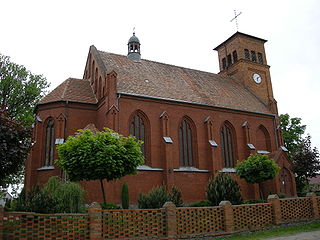
Gmina Sicienko is a rural gmina in Bydgoszcz County, Kuyavian-Pomeranian Voivodeship, in north-central Poland. Its seat is the village of Sicienko, which lies approximately 17 kilometres (11 mi) north-west of Bydgoszcz.
Gmina Mrocza is an urban-rural gmina in Nakło County, Kuyavian-Pomeranian Voivodeship, in north-central Poland. Its seat is the town of Mrocza, which lies approximately 12 kilometres (7 mi) north of Nakło nad Notecią and 31 km (19 mi) north-west of Bydgoszcz.
Kruszyn Krajeński is a village in the administrative district of Gmina Białe Błota, within Bydgoszcz County, Kuyavian-Pomeranian Voivodeship, in north-central Poland. It lies 4 kilometres (2 mi) south-west of Białe Błota and 10 km (6 mi) south-west of Bydgoszcz.

Dąbrówka Nowa is a village in the administrative district of Gmina Sicienko, within Bydgoszcz County, Kuyavian-Pomeranian Voivodeship, in north-central Poland. It lies approximately 3 kilometres (2 mi) south-east of Sicienko and 14 km (9 mi) north-west of Bydgoszcz.
Goncarzewy is a village in the administrative district of Gmina Sicienko, within Bydgoszcz County, Kuyavian-Pomeranian Voivodeship, in north-central Poland. It lies 4 kilometres (2 mi) west of Sicienko and 20 km (12 mi) north-west of Bydgoszcz.
Kruszyniec is a village in the administrative district of Gmina Sicienko, within Bydgoszcz County, Kuyavian-Pomeranian Voivodeship, in north-central Poland. It lies approximately 7 kilometres (4 mi) south-east of Sicienko and 11 km (7 mi) west of Bydgoszcz.
Łukowiec is a village in the administrative district of Gmina Sicienko, within Bydgoszcz County, Kuyavian-Pomeranian Voivodeship, in north-central Poland. It lies approximately 11 kilometres (7 mi) north-west of Sicienko and 27 km (17 mi) north-west of Bydgoszcz.
Mochle is a village in the administrative district of Gmina Sicienko, within Bydgoszcz County, Kuyavian-Pomeranian Voivodeship, in north-central Poland. It lies 5 kilometres (3 mi) east of Sicienko and 14 km (9 mi) north-west of Bydgoszcz.
Murucin is a village in the administrative district of Gmina Sicienko, within Bydgoszcz County, Kuyavian-Pomeranian Voivodeship, in north-central Poland. It lies approximately 11 kilometres (7 mi) north-west of Sicienko and 27 km (17 mi) north-west of Bydgoszcz.
Pawłówek is a village in the administrative district of Gmina Sicienko, within Bydgoszcz County, Kuyavian-Pomeranian Voivodeship, in north-central Poland. It lies approximately 9 kilometres (6 mi) south-east of Sicienko and 8 km (5 mi) north-west of Bydgoszcz.
Sicienko is a village in Bydgoszcz County, Kuyavian-Pomeranian Voivodeship, in north-central Poland. It is the seat of the gmina called Gmina Sicienko. It lies 17 km (11 mi) north-west of Bydgoszcz.
Sitno is a village in the administrative district of Gmina Sicienko, within Bydgoszcz County, Kuyavian-Pomeranian Voivodeship, in north-central Poland. It lies approximately 2 kilometres (1 mi) north of Sicienko and 18 km (11 mi) north-west of Bydgoszcz.
Szczutki is a village in the administrative district of Gmina Sicienko, within Bydgoszcz County, Kuyavian-Pomeranian Voivodeship, in north-central Poland. It lies 7 kilometres (4 mi) east of Sicienko and 13 km (8 mi) north-west of Bydgoszcz.
Trzemiętowo is a village in the administrative district of Gmina Sicienko, within Bydgoszcz County, Kuyavian-Pomeranian Voivodeship, in north-central Poland. It lies 5 kilometres (3 mi) north-west of Sicienko and 21 km (13 mi) north-west of Bydgoszcz.
Wojnowo is a village in the administrative district of Gmina Sicienko, within Bydgoszcz County, Kuyavian-Pomeranian Voivodeship, in north-central Poland. It lies 3 kilometres (2 mi) north-east of Sicienko and 15 km (9 mi) north-west of Bydgoszcz.
Zawada is a village in the administrative district of Gmina Sicienko, within Bydgoszcz County, Kuyavian-Pomeranian Voivodeship, in north-central Poland. It lies approximately 2 kilometres (1 mi) south-west of Sicienko and 17 km (11 mi) north-west of Bydgoszcz.
Zielonczyn is a village in the administrative district of Gmina Sicienko, within Bydgoszcz County, Kuyavian-Pomeranian Voivodeship, in north-central Poland. It lies 6 kilometres (4 mi) south of Sicienko and 13 km (8 mi) west of Bydgoszcz.

Kazimierz III of Gniewkowo, was a Polish prince member of the House of Piast, Duke of Inowrocław during 1287-1314, since 1306 vassal of the Kingdom of Poland, Governor of the Duchy of Pomerelia during 1306-1309, after 1314 ruler over Gniewkowo.
Józef Spors was a Polish historian, specializing in the medieval History of Poland and its northern region - Pomerania.

Halcnovian(Altsnerisch/Päurisch), alternatively spelled Haltsnovian, is an East Central German dialect spoken in the former village of Hałcnów, which is now a district of Bielsko-Biała, Poland. It was the vernacular language of Hałcnów until 1945, when ethnic Germans were expelled from Poland. Some examples of the language were recorded in the works of Karl Olma (1914–2001), who was active as a journalist in the Halcnovian exile community in West Germany after World War II. Recently the dialect has been researched from a linguistic standpoint by Marek Dolatowski. It is related to the Wymysorys language.





